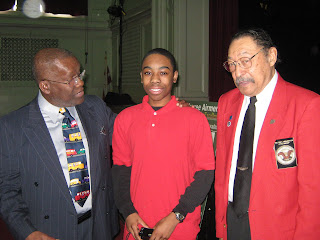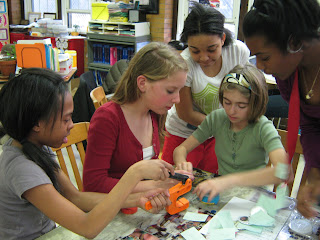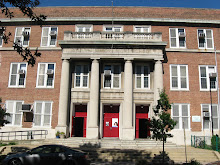Teresa stands next to a collection of hair clippings from each of the first 14 presidents. Her president's hair clipping is among those seen here.
On Thursday, February 12, 8th graders spent the day at the recently re-opened National Museum of American History. They had class in the museum, rotating between four different exhibits (one for each of their core classes). For History they visited "The American Presidency: A Glorious Burden," to compliment and conclude their unit on the United States Presidents and Presidency. Their assignment was two fold: 1) Find an object from your President (assigned at the beginning of the unit) and 2) Using a worksheet provided, critique the exhibit as if you were writing for a DC tourism agency.
by Gary
My president is John F. Kennedy. The object I chose was a drum. I chose the drum because I like playing drums. Also it was the only thing that captivated my attention and related to my president. The reason this drum relates to my president JFK is because it was one of the original drums played at his funeral. This tells me that he was assassinated. Another interesting fact I learned is that JFK was a Roman Catholic.
by Terrisha
The president I was assigned was our 43rd president, George W. Bush. I had a hard time finding an object on my president at first. Then when I came to an interesting exhibit I found it. The object I found was a Jack-in-the-box. When you wind it up Bush's upper body behind a podium pops up. I believe he is giving a speech. It shows Bush as president. I found this in the movie gallery. There were objects, political cartoons, and a clip about actors portraying a president.
The exhibit was named "The American Presidency: A Glorious Burden." A thing I found interesting was the first exhibit and the way it displays, identifies, and describes the hats of the president. The exhibit explained the presidency: the hardships, and the good things about the job. They explained this in objects, pictures, and small movie clips. One thinkg I learned in this exhibit was that James Buchanan's inaugural address was the first one photographed. Another fact I learned was that Millard Fillmore had the first kitchen installed in the White House.
by Breana
James Monroe was orh in 1758 and died July 4, 1831. He served one term as governor of VA and then was sent to France by Thomas Jefferson to negotiate the Louisiana Purchase. In 1811 he was appointed Secretary of State under President James Madison and in 1816 Monroe won the presidential election. James was the 5th president of the United States for two terms. 1816-1825 and is mose well know for the Monroe Doctrine. If you don't know what the Monroe Doctrine did, it stated that European powers were no longer allowed to colonize in the Americas.
During the exhibit I saw some interesting objects about James Monroe and other presidents. James had a dessert place with an eagle on it. In my opinion he had bad taste in platters. It also told me that he liked sweets and was a normal guy by eating what the average American eats. I chose this plate because it stood out the most to me. Another object that stood out tome was the master key. I know I could have picked an object that wasn't in the average household but I felt like once the president got this key it was official that he lived in the White House. I felt this way because if you have the master key that means you have access to any room whenever you want.
by Aaron
My assigned president was Calvin Coolidge, who presided over the country from 1923 until 1929. The object from the American History Museum's presidential exhibit that I chose to take a picture with was the formal dress worn by Coolidge's wife, and First Lady, Grace. I think this dress represents luxurious life in the booming 1920s, when the nation's economy was thriving. That time, however, eventually led to the Great Depression. I think the most interesting part of the exhibit was the array of personal artifacts, such as Teddy Roosevelt's riding chaps adn travel desk.

Tiesha stands next to Harry S. Truman's vacation shirt.
by Liz
Welcome to DC! While you're here, I'm sure you'd like to take a visit to the Smithsonian museums! At the National Museum of American History Museum, there is an exhibit called The American Presidency: A Glorious Burden, which is amazingly informative and interesting. It shows you the various "hats" that a president must wear: Chief Executive, Commander in Chief, National Leader, and many others. There are explanations and examples for each figurative "hat." A Glorious Burden shows you the personal life of the presidents, with artifacts of first kids such as dollhouses, ballet slippers, and baseballs. They also show you the professional side of life, with videos of famous speeches and campaign buttons. There are objects that related to every president in history--with the exception of our most recent one. The exhibit engages those who know everything about the presidents, and those who know none. It has a video where you can see yourself on the screen as though you're giving the Inaugural Address, and you have a teleprompter to guide you through famous speeches. The only downside is the small font size on some of the labels. Overall, the exhibit demonstrates very accurately the glorious burden of the presidency: the joy of election, the happiness of a country's love, but also the sadness of being protested, the physical danger, and the mental stress.
The American Presidency: A Glorious Burden
by Kelsea
Located in The National Museum of American History is “The American Presidency: A Glorious Burden” exhibit. This exhibit focuses on the tasks and lives of the United States’ Presidents. Whoever planned this part of the museum did a wonderful job of ensuring that the exhibition matched the title. One label read, “There have been 11 attempts to kill a president”. A death threat is certainly a burden. The glorious parts of a president’s life are illustrated through pictures of various presidents with their kids and family and through quotes some presidents said.
Presidents have many roles or “hats.” This gallery did an excellent job of discussing them. The wall of the gallery’s middle room was lined with glass cases, each titled with one of the hats, i.e. “National Leader, Chief executive.” Each respective case explained and gave examples of the roles/hats. One of them said, “This is an engraving of President Lincoln’s cabinet.” There was also a movie thoroughly explaining each role of a president.
If you enter one of the rooms in this exhibition, you’ll see “Bill Clinton’s saxophone”, or a “Wooden bowling pin used during Harry Truman’s term”, or “Chelsea Clinton’s point shoes”. You can’t dive much deeper into our presidents’ personal lives than showing actual items from their personal lives. That’s yet another good quality this exhibition possesses.
Every presidency has a story. And, stories are always better when there are primary sources involved. With that said, this gallery does a great job of telling the story of the presidency. Many old objects from campaign trials are on display. There’s even an old telegraph machine and toys the first children used. (The telegraph machine was Chester Alan Arthur’s.)
Is this exhibit engaging? As Sarah Palin would say, “You betcha!” A perfect example is the “You be The President Interactive Speech”. Here, visitors can read clips of presidential speeches from a teleprompter while watching themselves on camera. This is a creative and fun way to allow visitors to interact.
Organization is key to any museum exhibit, gallery, and/or display. The National Museum of American History has seemed to grasp that concept. The “hats” are in one section, campaign souvenirs in another. There is a room dedicated to personal life and a gallery dedicatd to Lincoln. NMAH has organization and accessibility down to a science.
Despite all the positive aspects of “The American Presidency: A Glorious Burden”, I would suggest you not come here if you aren’t familiar with the presidency. Personally, I feel that unless you have a good understanding of the American presidency and the history of American presidents, it would be hard for you to enjoy this exhibit. Most of the objects are primary sources such as a folder for “blank telegraph forms” and old political cartoons and exerts from speeches. But, this gallery fails to give you a background on these items/things. For example, for “You Be The President” there is no explanation as to why these presidents gave these speeches. There’s no background on what was happening in the country at that time. This is probably my only compliant about the exhibit.
Overall, I recommend a trip to this museum and specifically this gallery, “The American Presidency: A Glorious Burden.” You’ll enjoy yourself and be glad you came.

































